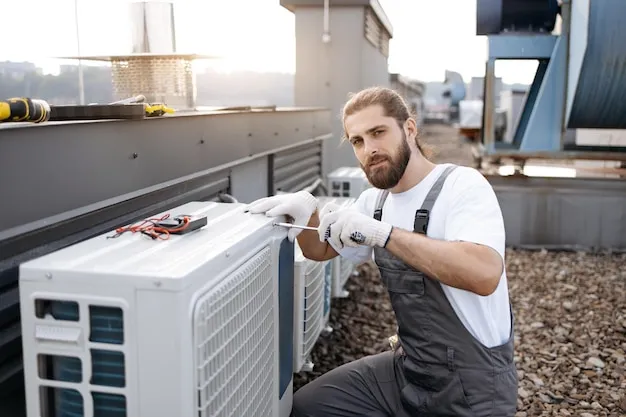When it comes to heating (and cooling) with Packaged Terminal Air Conditioners (PTACs), you essentially have two paths to choose from: electric resistance heat or a heat pump. The right pick hinges on your climate, budget and how you use the space. This is where the PTAC heat pump vs electric heat debate becomes important. Let’s break it down into no jargon, just straight talk.
How They Work: The Basics
- Electric Heat PTACs are simple: they use metal coils that heat up when electricity passes through, much like a space heater. A fan blows over these coils to distribute warmth. Reliable, direct, and effective—especially on the chilliest days.
- Heat Pump PTACs, on the other hand, don’t generate heat—they move it. In winter, they pull warmth from the outdoor air and bring it inside; in summer, they switch roles and act as an air conditioner. It’s a clever, dual-purpose setup and often a key point in the PTAC heat pump vs electric heat choice.
For people comparing different HVAC options, many also weigh PTAC units vs mini splits since both provide heating and cooling but serve spaces differently.
Pros & Cons at a Glance
Electric Heat PTAC
Pros:
- Works regardless of how cold it gets—even well below freezing.
- Fewer moving parts mean less can go wrong.
- Lower upfront cost—budget-friendly.
- Heats quickly, giving almost instant warmth.
Cons:
- High electricity usage drives up running costs.
- Only heats—no cooling function included.
- Not eco-friendly unless your electricity source is clean.
Heat Pump PTAC
Pros:
- Much more energy efficient—uses electricity to move heat rather than generate it.
- Doubles as an air conditioner service offering year-round comfort.
- Lower utility bills in moderate climates.
Cons:
- Less efficient in truly cold temps—below ~25–35 °F, performance drops off.
- Higher initial cost thanks to the compressor and added parts.
- More complex mechanics mean maintenance can be more involved.
This comparison highlights the practical differences in the PTAC heat pump vs electric heat decision.
Upfront vs Operating Costs
From recent data:
| Feature | Heat Pump PTAC | Electric Heat PTAC |
|---|---|---|
| Upfront Cost | $950–$1,500 | $750–$1,100 |
| Efficiency (COP) | ~3.0+ (EER 9–11) | ~1.0 (EER 8–9) |
| Operating Cost | Low (especially in mild weather) | High in extended heating use |
| Cold-Weather Performance | Drops below 25 °F | Excellent at all temperatures |
Key insight: The DOE (U.S. Department of Energy) says heat pumps can use about 50% less electricity compared to electric resistance heating, leading to substantial savings.
Choosing Based on Climate & Usage
- Cold Regions (frequent freeze) → Electric Heat PTAC wins—consistent warmth, simplicity.
- Temperate or Mild Winters → Heat Pump PTAC is ideal—energy savings and year-round utility.
- Occasional-use Spaces (guest rooms, seasonal cabins) → Electric may suffice—lower upfront cost, minimal maintenance.
- Daily-use Zones (rentals, home offices) → Heat pump offers better ROI and lower bills.
In some cases, property owners even consider PTAC units vs mini splits, especially when balancing installation costs, aesthetics, and long-term energy savings.
Noise & Maintenance Notes
Noise:
- Electric heat units are generally quieter since they don’t have a compressor.
- Heat pumps hum when the compressor runs—like a typical AC.
Durability:
- Electric resistive units have simpler mechanics and fewer parts to fail.
- Heat pumps are durable, but the compressor requires occasional professional maintenance and potential repairs.
Tip in Real Life: On forums, landlords noted heat pumps cost more initially but offered big savings in energy costs—so it quickly pays off if you’re footed with the electric bill. That’s why many recommend carefully studying PTAC heat pump vs electric heat before buying.

Power & Wiring Considerations
Before buying either, check your electrical setup. Both require dedicated circuits:
- Electric Heat PTAC: often 208/230 V, 20–30 amps.
- Heat Pump PTAC: similar voltage but slightly lower amps, around 15–20.
Consult an electrician to ensure safety and compatibility. For larger spaces or multi-room coverage, some even compare PTAC units vs mini splits to see which setup suits their property best.
A Nod to New Coolair
If you’re shopping for a PTAC or need professional installation, services like New Cool Air stand out. They specialize in PTAC units, repairs, and installations—especially handy in places like NYC where PTAC maintenance can be tricky. Whether you’re looking to replace an old unit or install a new heat pump setup, their expertise ensures smooth, reliable operation. Just one quick shout-out to how they’re a helpful partner in real-world PTAC decisions.
Final Thoughts—Quick Checklist
Go for a Heat Pump PTAC if you:
- Live in a region with mild winters (above ~35 °F regularly)
- Run heating and cooling often
- Want to save on energy bills
- Appreciate dual-purpose functionality
Stick with Electric Heat PTAC if you:
- Face very cold climates often
- Use the space only occasionally
- Prioritize lower upfront cost and minimal upkeep
- Want fast, simple, reliable heat
Frequently Asked Questions:-
Q. What is the difference between a PTAC heat pump and electric heat?
Ans : The main comparison of PTAC heat pump vs electric heat lies in how they work—heat pumps transfer heat, while electric PTACs generate it directly.
Q. Which PTAC option is more energy-efficient?
Ans : Heat pump PTACs are more efficient, especially in mild climates, while electric ones consume more power.
Q. Do heat pumps work in very cold weather?
Ans : Not always—below 25–30°F, performance drops, which is why many compare PTAC units vs mini splits for efficiency in colder regions.
Q. Which PTAC has a lower upfront cost?
Ans : Electric heat PTACs usually cost less to buy, though they may lead to higher long-term energy bills.
Q. Who can help with PTAC installation?
Ans : Experts like New Coolair provide professional PTAC installation and service, ensuring the right fit for your space.
Conclusion
Both systems have their place. Electric heat offers reliability and simplicity at a lower cost, while heat pumps bring efficiency and versatility—but shine brightest when used consistently in temperate climates. So when comparing PTAC heat pump vs electric heat, think about your climate and usage patterns. And if you’re weighing broader options like PTAC units vs mini splits, factor in installation costs, energy savings, and long-term comfort. Whether you choose one or the other, pros like New Cool Air can help you dial in the best fit for your space.



